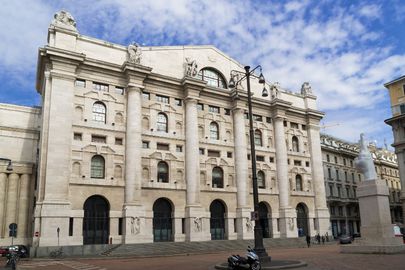

The Midnight Palace, if literally translated to English, is the seat of the Italian Stock Exchange. The name obviously has a very mysterious aura, alluding perhaps to a secret society that met only at night or to some other nocturnal feat. But the truth behind the name is rather unimaginative: the building was named after its architect, Paolo Mezzanotte.
The palace was constructed between 1929 and 1933, at the height of the Fascist Era, with the objective of uniting all the city's exchange activities under one roof. Several buildings had to be taken down in order to make room for the new palace, but the most important ones in the zone, Palazzo Turati and the Buffoni Galleria, were left in their places. While laying the foundation, the constructors discovered some ruins from an ancient Roman theater, which still lie under the Palazzo Mezzanotte.
The palace occupies a total territory of 6,450 square meters. It was an avant-garde building for its time in Italy. It was the first building to have multiple elevators that could be called simultaneously, to have an air conditioning system that worked on water and vapor, and its most impressive gadget was a huge electric board displaying the quotations of the 78 stock names of the Milan Exchange, the biggest in Italy.
It is difficult to determine the style of the building, especially its façade. The safest explanation would be that it is a mixture of Neoclassicism and Futurism. The 36-meter high façade was built from Travertine marble and looks out onto the Piazza Affari, that is, Business Square.
The most important chamber inside the palace is the enormous Hall of Cries, in which the frenetic stockbrokers shouted out the stock prices and quickly made their deals. Since the 1990s, however, all transactions have been telematic, which has removed all the drama and gusto from buying and selling stocks.
Surprisingly, the Milanese stock exchange was not the first to be established on the Italian peninsula. It was not even second or third. It was set up in 1808, during Napoleon's Italian Kingdom - six years after the one in Rome, thirty-three years after the one in Trieste and one hundred and seventy-eight years after the first stock exchange to be introduced in what today is Italy, the Venetian Stock Exchange. Towards the end of the 19th and beginning of the 20th centuries, after Italy's unification, the national economy was growing fast and Milan, although not the political capital, was definitely becoming the country's financial capital. Milan was the most industrialized Italian city, and therefore its stock exchange handled the stocks of all the major industrial companies. It therefore needed bigger and bigger structures to provide space for the growing volumes of transactions. The Milanese stock exchange had had three different buildings before moving into the Palazzo Mezzanotte. The last one had been Palazzo Broggi, the elegant Liberty style building standing on the nearby Piazza Cordusio, between the Duomo and the Castello Sforzesco.
Although Italy, like most western countries, had also suffered after the Wall Street Crash in 1929, the national economy was always held together by giants such as Fiat, Pirelli, Edison the energy company, the insurance and financial companies RAS and Assicurazioni Generali, and Bastogi, the holding company specializing in hotel management and cultural events.
After World War II Italy experienced a vibrant economic boom and there was a period in the 1960s when Italy was considered the motor of Europe. This status made Milan the commercial hub of the continent, although few international companies were quoted in Italy. In 1997 the government decided to unite all the individual stock exchanges found on Italian territory into one single Italian Stock Exchange. This stock exchange was established in the Palazzo Mezzanotte in Milan.